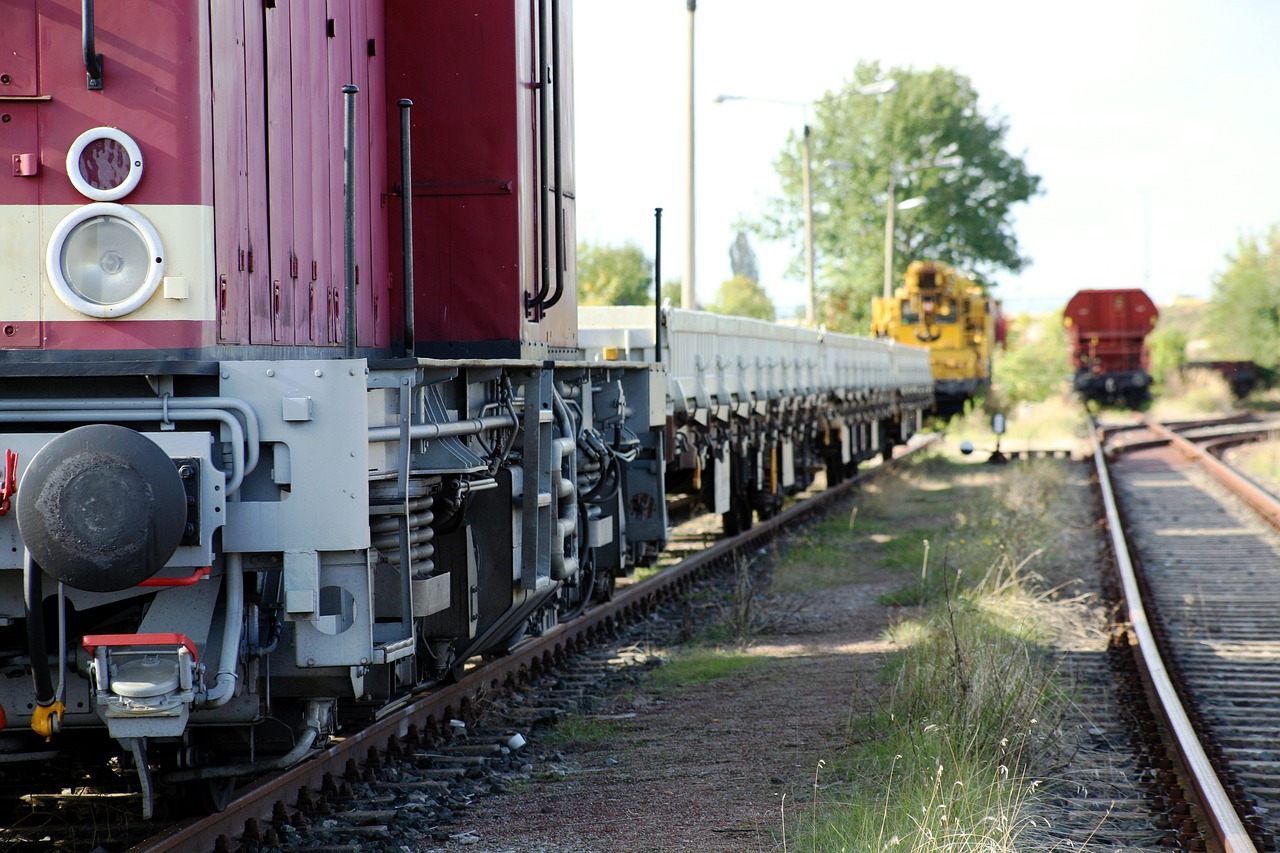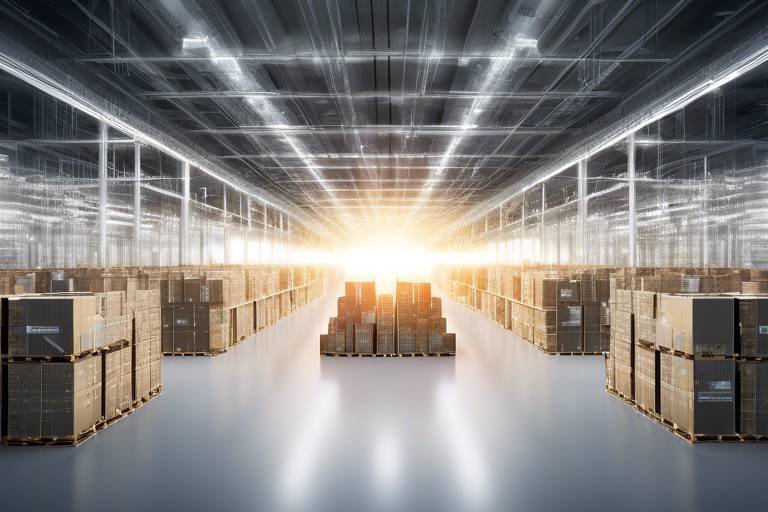How Robotics is Transforming Supply Chain Management
The world of supply chain management is undergoing a radical transformation, and at the heart of this revolution is robotics. Imagine a bustling warehouse where robots glide effortlessly, picking, packing, and sorting goods with precision. This isn't science fiction; it's the new reality of logistics and operations across various industries. In this article, we'll explore how robotics technology is being integrated into supply chain processes, enhancing productivity and accuracy while simultaneously reducing costs and minimizing human error.
Robotics is no longer a futuristic concept; it's a present-day solution that is reshaping how we think about supply chains. The integration of robotic systems into supply chains is akin to adding a turbocharger to a car—it boosts efficiency and performance dramatically. From automated guided vehicles (AGVs) to robotic arms, these technologies are designed to streamline operations and optimize workflows. As businesses strive for greater efficiency, the adoption of robotics in supply chains is becoming not just beneficial, but essential.
When we talk about robotics in supply chains, it's important to understand the different types of robots that are making waves in this field. Each type serves a unique purpose, contributing to the overall efficiency of operations. Here’s a closer look at some of the most common types:
- Automated Guided Vehicles (AGVs): These robots transport materials around a warehouse or manufacturing facility, navigating through predefined paths.
- Robotic Arms: Used for tasks such as picking, packing, and sorting, robotic arms bring speed and precision to manual processes.
- Drones: Increasingly used for inventory management and delivery, drones can quickly cover large areas and provide real-time data.
AGVs are revolutionizing warehouse automation. Picture a scenario where goods are transported seamlessly from one point to another without human intervention. AGVs are equipped with advanced navigation systems that allow them to move safely around obstacles, making them an integral part of modern supply chains. They enhance material handling efficiency while minimizing labor costs, thereby allowing human workers to focus on more strategic tasks.
The advantages of using AGVs in supply chains are numerous:
- Increased Safety: By automating the transport of goods, AGVs reduce the risk of workplace accidents.
- Reduced Operational Costs: With fewer human workers needed for transport tasks, companies can save significantly on labor costs.
- Enhanced Workflow Efficiency: AGVs can operate continuously, leading to faster turnaround times and improved productivity.
While the benefits are clear, integrating AGVs into existing systems does come with challenges. Initial costs can be a barrier, as well as ensuring technology compatibility with current systems. Moreover, workforce adaptation is crucial, as employees may need to adjust to a new way of working alongside robotic systems.
Robotic arms are another key player in the supply chain revolution. These machines excel in tasks that require precision and speed, such as picking items from shelves and packing them for shipment. Imagine a robotic arm that can pick and sort thousands of items in a fraction of the time it would take a human worker. This not only increases throughput but also significantly reduces errors, leading to more accurate order fulfillment.
The rise of robotics in supply chains presents a double-edged sword for the labor market. On one hand, there are concerns about job displacement; on the other, the emergence of new roles in tech, maintenance, and management. As companies adopt robotic systems, they will need skilled workers to manage and maintain these technologies, creating opportunities in fields that didn't exist a decade ago.
It's essential to take a balanced view of the impact of robotics on employment. While some jobs may be displaced, the overall landscape is shifting towards job creation in areas like technology and automation management. The key is to prepare the workforce for these new opportunities.
To ensure that workers can thrive in a robotic environment, training programs are vital. Reskilling and upskilling initiatives will equip employees with the necessary skills to adapt to an increasingly automated workplace. Companies that invest in their workforce will not only enhance productivity but also foster loyalty and job satisfaction.
Looking ahead, the future of robotics in supply chain management is bright. We can expect to see advancements in artificial intelligence (AI) and machine learning that will lead to even smarter and more autonomous supply chain solutions. Robotics will not just be about automation; it will be about creating intelligent systems that can learn and adapt to changing conditions.
Artificial intelligence is set to enhance robotic capabilities significantly. Imagine robots that can analyze data in real-time, make decisions, and optimize their operations without human input. This level of intelligence will transform supply chains into highly efficient ecosystems that can respond dynamically to market demands.
Finally, robotics can play a crucial role in promoting sustainable supply chain practices. By optimizing operations, robots can help reduce waste and energy consumption, contributing to a greener planet. As businesses increasingly focus on sustainability, integrating robotics into their supply chains will be a key strategy.
Q1: How do robots improve supply chain efficiency?
A1: Robots enhance efficiency by automating repetitive tasks, reducing errors, and increasing the speed of operations.
Q2: Will robots replace human jobs in supply chains?
A2: While some jobs may be displaced, robotics will also create new roles in technology and management, requiring workforce adaptation.
Q3: What skills are necessary for workers in a robotic environment?
A3: Workers will need skills in technology management, maintenance, and data analysis to thrive in an increasingly automated workplace.

Introduction to Robotics in Supply Chains
In today's fast-paced world, the integration of robotics technology into supply chain management is nothing short of revolutionary. Imagine a bustling warehouse where goods are moved with precision and speed, all thanks to the collaboration of humans and machines. This is not just a futuristic dream; it’s happening right now! Robotics is enhancing productivity and accuracy while slashing costs and minimizing human error. As we dive deeper into this topic, you'll discover how various types of robots are reshaping the logistics landscape and why industries are racing to adopt these innovations.
The adoption of robotics in supply chains is driven by the need for efficiency. With the rise of e-commerce and customer expectations for quick deliveries, businesses are turning to robots to streamline their operations. For instance, automated guided vehicles (AGVs) are becoming the backbone of warehouse automation, navigating through aisles with ease and transporting goods from one point to another without human intervention. Moreover, robotic arms are revolutionizing tasks like picking, packing, and sorting, showcasing their remarkable speed and precision.
But why stop there? The future of supply chains is also intertwined with artificial intelligence (AI) and machine learning. These technologies are not only making robots smarter but also enabling them to learn from their surroundings, adapt to changes, and optimize their performance over time. As we explore the various facets of robotics in supply chains, we'll also touch upon the challenges and benefits that come with this transformation. From job displacement concerns to the necessity of reskilling the workforce, the conversation around robotics is as dynamic as the technology itself.
In summary, the integration of robotics into supply chain management is a game-changer. It promises to enhance efficiency, reduce costs, and improve accuracy, all while paving the way for a more sustainable future. As we continue this exploration, keep in mind the profound impact these technologies are having not just on businesses, but on the workforce and the environment as well. Are you ready to delve deeper into how robotics is transforming the supply chain landscape?

Types of Robotics Used in Supply Chains
As we venture into the world of supply chain management, it becomes increasingly clear that robotics is not just a fleeting trend but a transformative force reshaping the landscape. Various types of robotics are being employed to enhance efficiency, accuracy, and productivity across different sectors. From Automated Guided Vehicles (AGVs) that navigate warehouses autonomously to robotic arms that excel in precision tasks, each type plays a crucial role in streamlining operations.
One of the standout innovations in this realm is the use of drones. These flying robots are not merely toys; they are revolutionizing inventory management and delivery processes. Imagine a warehouse where drones zip around, scanning barcodes and ensuring that stock levels are accurate without a human ever having to lift a finger. This not only saves time but also minimizes human error, which can lead to costly mistakes.
Now, let’s break down some of the key types of robotics utilized in supply chains:
- Automated Guided Vehicles (AGVs): These mobile robots are designed to transport materials within a facility without human intervention. They rely on various navigation technologies, such as lasers, magnets, or cameras, to move from point A to point B.
- Robotic Arms: Commonly used in manufacturing and warehousing, these versatile machines are capable of performing repetitive tasks such as picking, packing, and sorting items with incredible speed and accuracy.
- Drones: Equipped with cameras and sensors, drones can perform aerial inventory checks, monitor stock levels, and even facilitate last-mile delivery, making them a game-changer in logistics.
Each of these robotic types brings unique advantages to the table. For instance, AGVs can operate around the clock, ensuring that goods are moved efficiently without the need for breaks or downtime. On the other hand, robotic arms can handle delicate items with precision, significantly reducing the risk of damage during the packing process.
Moreover, the integration of these technologies leads to a more cohesive and responsive supply chain. As businesses increasingly adopt robotics, we can expect to see a shift toward more automated processes. This not only enhances productivity but also allows human workers to focus on more complex tasks that require creativity and critical thinking.
In conclusion, the types of robotics used in supply chains are diverse and impactful. As we continue to innovate and integrate these technologies, the future of supply chain management looks promising. The synergy between human intelligence and robotic efficiency is paving the way for a new era of logistics that promises to be faster, smarter, and more efficient than ever before.
Q1: What are the main types of robotics used in supply chains?
A1: The main types include Automated Guided Vehicles (AGVs), robotic arms, and drones. Each serves a specific function in enhancing efficiency and accuracy in logistics.
Q2: How do AGVs improve supply chain operations?
A2: AGVs automate the transportation of goods within a facility, reducing labor costs and minimizing the risk of human error. They can operate continuously, enhancing overall workflow efficiency.
Q3: Are there challenges in implementing robotics in supply chains?
A3: Yes, challenges include initial setup costs, technology compatibility with existing systems, and the need for workforce adaptation to new technologies.
Q4: How do robotic arms contribute to warehousing?
A4: Robotic arms excel in tasks like picking, packing, and sorting items quickly and accurately, which helps streamline operations and reduce labor costs.
Q5: What future trends can we expect in robotics and supply chains?
A5: Future trends may include increased integration of artificial intelligence, leading to smarter robotic systems, as well as a greater focus on environmental sustainability through efficient operations.

Automated Guided Vehicles (AGVs)
Automated Guided Vehicles, or AGVs, are revolutionizing the way warehouses and distribution centers operate. Think of AGVs as the modern-day equivalent of the conveyor belt but with a twist—they are mobile, intelligent, and can navigate their environment autonomously. These vehicles use a combination of sensors, cameras, and advanced algorithms to transport goods from one point to another without human intervention. The technology behind AGVs has evolved significantly over the years, leading to increased efficiency and productivity in supply chain operations.
One of the standout features of AGVs is their navigation systems. Unlike traditional forklifts that require a human operator, AGVs can follow predefined paths or use sophisticated mapping technologies to navigate complex warehouse layouts. They can detect obstacles in real-time, allowing them to make instantaneous decisions about rerouting. This capability not only enhances safety but also minimizes the risk of accidents that could lead to costly downtime.
When it comes to material handling, AGVs excel in various tasks. They can transport pallets, boxes, and even heavy equipment across vast distances within a facility. Their ability to operate continuously without fatigue means they can significantly increase throughput, allowing companies to meet growing demand without the need for additional labor. In fact, the integration of AGVs can lead to a reduction in operational costs by streamlining processes and minimizing the need for manual labor.
However, the implementation of AGVs is not without its challenges. Organizations must consider factors such as initial costs, which can be substantial, especially for small to medium-sized enterprises. Additionally, there’s the question of technology compatibility with existing systems. AGVs need to be integrated with warehouse management systems (WMS) to function optimally. This integration requires careful planning and sometimes significant adjustments to current workflows.
Moreover, the workforce must adapt to this new technology. Employees may feel apprehensive about AGVs taking over their roles, leading to potential resistance. However, with the right training and communication, workers can learn to collaborate with these vehicles, utilizing their capabilities to enhance their own productivity. In the long run, AGVs represent not just a change in how tasks are performed, but an opportunity for workers to focus on more complex and fulfilling roles within the supply chain.
In summary, AGVs are a game-changer in supply chain management. They offer a blend of efficiency, safety, and cost-effectiveness that is hard to ignore. As technology continues to advance, we can expect AGVs to become even more sophisticated, further transforming the logistics landscape and setting new standards for operational excellence.
- What are AGVs? Automated Guided Vehicles are mobile robots that transport materials within a facility without human intervention.
- How do AGVs navigate? They use a combination of sensors, cameras, and mapping technologies to navigate their environment and avoid obstacles.
- What are the benefits of using AGVs? AGVs increase efficiency, reduce operational costs, enhance safety, and allow for continuous operation without fatigue.
- What challenges come with implementing AGVs? Initial costs, technology compatibility, and workforce adaptation are some of the challenges organizations may face.

Benefits of AGVs
Automated Guided Vehicles (AGVs) are revolutionizing the way supply chains operate, bringing a plethora of benefits that significantly enhance efficiency and productivity. One of the most notable advantages of AGVs is their ability to improve safety in the workplace. By reducing the need for human intervention in potentially hazardous environments, AGVs minimize the risk of accidents and injuries. Imagine a bustling warehouse where heavy loads are constantly being moved—AGVs take on the heavy lifting, allowing human workers to focus on more strategic tasks.
Furthermore, AGVs contribute to cost reduction. While the initial investment in AGV technology can be substantial, the long-term savings are undeniable. By automating material handling processes, companies can significantly decrease labor costs, as fewer workers are needed to perform repetitive tasks. Additionally, AGVs operate with high precision, leading to reduced waste and errors in order fulfillment. This not only enhances customer satisfaction but also boosts overall profitability.
Another key benefit of AGVs is their ability to enhance workflow efficiency. These vehicles can operate around the clock, tirelessly moving goods from one point to another without the need for breaks. This continuous operation leads to quicker turnaround times and increased throughput. For instance, in a warehouse setting, AGVs can seamlessly transport products from receiving to storage, and then to shipping, creating a streamlined process that keeps products flowing smoothly through the supply chain.
Moreover, AGVs are designed to be flexible and scalable. As businesses grow and change, AGVs can be easily reprogrammed or adjusted to accommodate new layouts or different types of products. This adaptability makes them an ideal solution for dynamic environments where demand fluctuates. In contrast to traditional fixed automation, AGVs provide a level of versatility that is crucial in today’s fast-paced market.
In summary, the integration of AGVs into supply chains offers a multitude of benefits, including:
- Increased Safety: Reduces workplace accidents by minimizing human involvement in dangerous tasks.
- Cost Efficiency: Lowers labor costs and decreases operational errors.
- Enhanced Workflow: Operates continuously, improving throughput and turnaround times.
- Flexibility: Easily adaptable to changing operational needs.
As we continue to embrace technological advancements in supply chain management, AGVs stand out as a transformative force that not only enhances operational efficiency but also paves the way for a safer and more productive future.
- What are AGVs? Automated Guided Vehicles (AGVs) are mobile robots that follow markers or wires in the floor, or use vision or lasers for navigation, to transport materials in a facility.
- How do AGVs improve safety in the workplace? AGVs minimize human intervention in hazardous tasks, reducing the risk of accidents and injuries.
- Are AGVs cost-effective? While the initial investment can be high, AGVs lead to significant long-term savings through reduced labor costs and increased operational efficiency.
- Can AGVs adapt to changing environments? Yes, AGVs are designed to be flexible and can be reprogrammed or adjusted to accommodate new layouts or different types of products.

Challenges of Implementing AGVs
While Automated Guided Vehicles (AGVs) offer a plethora of advantages in enhancing supply chain efficiency, the journey to their implementation is not without its hurdles. One of the most significant challenges is the initial cost associated with acquiring and integrating these sophisticated machines into existing operations. Organizations often find themselves facing a hefty upfront investment, which can be daunting, especially for small to medium-sized enterprises. However, it’s crucial to view this as a long-term investment rather than a short-term expense.
Another major concern revolves around technology compatibility. Many businesses have existing systems that may not seamlessly integrate with AGVs. This lack of compatibility can lead to operational disruptions, and companies may need to invest further in upgrading their infrastructure, which adds to the complexity of the implementation process. It’s akin to trying to fit a square peg into a round hole; without the right adjustments, it simply won’t work.
Moreover, there’s the challenge of workforce adaptation. Employees may feel threatened by the introduction of AGVs, fearing job displacement or changes in their roles. This apprehension can lead to resistance against adopting new technologies. Companies must proactively address these concerns by fostering a culture of acceptance and providing thorough training programs. After all, a well-informed team can transform fear into enthusiasm, turning potential challenges into opportunities for growth.
In addition to these factors, organizations must also navigate issues related to maintenance and support. AGVs require regular upkeep to ensure they operate at peak efficiency. This means that businesses must either train their existing staff to handle maintenance or invest in external service contracts. Ensuring that AGVs are always in optimal condition is vital, as any downtime can lead to significant disruptions in the supply chain.
Lastly, there’s the need for a robust data management system to monitor the performance of AGVs. Companies must invest in software that can analyze data generated by these vehicles to optimize their routes and improve efficiency. Without proper data management, organizations may struggle to fully harness the potential of AGVs, leading to underwhelming results.
In conclusion, while the challenges of implementing AGVs are notable, they are not insurmountable. With careful planning, investment in the right technology, and a commitment to workforce development, businesses can successfully navigate these obstacles and reap the rewards of enhanced operational efficiency.
- What are AGVs? Automated Guided Vehicles are mobile robots that transport materials within a facility without human intervention.
- How can AGVs improve supply chain efficiency? AGVs streamline operations by reducing labor costs, minimizing human error, and speeding up material handling processes.
- What are the initial costs associated with AGVs? Costs can vary widely based on the type and complexity of the AGV system, but they often include purchase, installation, and integration expenses.
- How can companies address workforce concerns regarding AGVs? Providing training and clear communication about the role of AGVs can help alleviate fears and encourage acceptance among employees.
- What kind of maintenance do AGVs require? Regular inspections, software updates, and hardware maintenance are essential to keep AGVs functioning efficiently.

Robotic Arms in Warehousing
When we think about the future of warehousing, robotic arms are often at the forefront of the conversation. These sophisticated machines are revolutionizing how goods are handled, packed, and sorted, making operations not only faster but also more precise. Imagine a warehouse where tasks that once took hours can now be completed in minutes, thanks to the relentless efficiency of robotic arms. They are equipped with advanced sensors and artificial intelligence, allowing them to perform complex operations with incredible accuracy.
Robotic arms are designed to automate a range of tasks within the warehouse environment. From picking items off shelves to packing them into boxes, these machines can handle repetitive tasks that would typically require human labor. This automation not only speeds up the process but also minimizes human error, which can lead to costly mistakes. For instance, a robotic arm can consistently pick and place items without the fatigue or distraction that humans might experience over long periods.
One of the most significant advantages of robotic arms is their versatility. They can be programmed to perform various tasks, adapting to different workflows as needed. This flexibility is crucial in today’s fast-paced supply chain environment, where demands can change rapidly. With the ability to integrate seamlessly with existing systems, robotic arms can be deployed in various sectors, from e-commerce to manufacturing. They are particularly effective in environments where speed and accuracy are paramount, such as in distribution centers and fulfillment warehouses.
Let’s take a closer look at some of the specific tasks that robotic arms excel at in warehousing:
- Picking: Robotic arms can identify and select items from shelves with remarkable precision, reducing the time taken to gather products for orders.
- Packing: They can pack items into boxes or containers efficiently, ensuring that products are securely placed and ready for shipment.
- Sorting: Robotic arms can sort items based on various criteria, such as size, weight, or destination, streamlining the logistics process.
However, it’s important to acknowledge that integrating robotic arms into warehouse operations does not come without its challenges. Companies must consider the initial investment, ongoing maintenance, and the need for a skilled workforce to operate and manage these systems. Despite these hurdles, the long-term benefits often outweigh the costs, leading to improved productivity and efficiency.
In conclusion, robotic arms are not just a trend; they represent a fundamental shift in how warehouses operate. As technology continues to advance, we can expect these machines to become even more capable, further enhancing supply chain management. The future is bright for robotic arms in warehousing, and businesses that embrace this technology are likely to stay ahead of the competition.
Q1: How do robotic arms improve efficiency in warehouses?
A1: Robotic arms enhance efficiency by automating repetitive tasks, reducing the time taken for picking, packing, and sorting, and minimizing human error.
Q2: Are robotic arms expensive to integrate into existing systems?
A2: While the initial investment can be significant, the long-term savings in labor costs and increased productivity often justify the expense.
Q3: What industries benefit the most from robotic arms?
A3: Industries such as e-commerce, manufacturing, and logistics see the most significant benefits from robotic arms due to their need for speed and accuracy in operations.

Impact on Labor and Workforce
The rise of robotics in supply chain management is reshaping the landscape of labor and workforce dynamics in profound ways. As companies increasingly adopt automated solutions, there’s a growing concern about how these technologies will impact jobs. Will robots take over the workforce entirely, or will they create new opportunities? The truth lies somewhere in between, and it’s essential to understand both sides of the equation.
On one hand, the integration of robotics can lead to job displacement. Positions that involve repetitive tasks, such as manual sorting, packing, and even driving, are at risk of being replaced by machines that can perform these functions faster and more accurately. For example, a robotic arm can pick and sort items in a warehouse with precision that far exceeds human capabilities, which means that roles in these areas may diminish significantly. However, it’s crucial to recognize that while some jobs may disappear, others will emerge. The technology also creates a demand for skilled workers who can maintain, program, and oversee robotic systems.
In fact, the evolution of robotics is not just about elimination but also job creation. New roles are being developed in fields such as technology management, robotics maintenance, and data analysis. As businesses invest in these advanced systems, they require professionals who can manage and optimize their operations. For instance, a logistics company might need data analysts to interpret the vast amounts of data generated by robotic systems, leading to new career paths that didn’t exist a decade ago.
To navigate this transition, reskilling and upskilling the workforce becomes paramount. Companies must invest in training programs that equip their employees with the necessary skills to thrive in a robotic environment. This might include technical training on how to operate and troubleshoot robotic systems, as well as soft skills like problem-solving and critical thinking that are essential in a tech-driven workplace. By fostering a culture of continuous learning, organizations can help their employees adapt and find new roles within the changing landscape.
Interestingly, studies indicate that companies that prioritize employee training not only see higher retention rates but also improved overall productivity. A well-rounded workforce that embraces technology can navigate the complexities of modern supply chains more effectively. In this sense, the relationship between robotics and labor is not a zero-sum game; rather, it’s a dynamic interplay that can lead to a more skilled and versatile workforce.
In summary, while the rise of robotics in supply chain management poses challenges related to job displacement, it also opens doors to new opportunities and roles. The key lies in proactive measures taken by both companies and employees to adapt to these changes. By investing in reskilling initiatives, the workforce can evolve alongside technology, ensuring that human skills remain invaluable in an increasingly automated world.
- Will robots completely replace human workers in supply chains?
No, while robots will take over repetitive and manual tasks, they will also create new job opportunities that require human oversight and management. - What types of jobs are at risk due to robotics?
Jobs that involve routine tasks such as sorting, packing, and driving may be most affected, as these can be automated. - How can workers prepare for the changes brought by robotics?
Workers can prepare by engaging in reskilling and upskilling programs to learn new technologies and enhance their problem-solving skills. - Are there benefits to using robotics in supply chains?
Yes, robotics can lead to increased efficiency, reduced operational costs, and improved safety in supply chain operations.

Job Displacement vs. Job Creation
The conversation around robotics in the supply chain often revolves around a pressing question: Will robots take away jobs? It's a valid concern, especially in an era where technology is advancing at lightning speed. However, the reality is more nuanced than a simple yes or no. While it's true that certain roles may become obsolete, the rise of robotics also opens up a treasure trove of new opportunities. Think of it as a double-edged sword; one side cuts away old jobs, while the other side creates new ones.
To illustrate this point, consider the following: as robots take over repetitive and physically demanding tasks, human workers are freed up to engage in more complex and creative roles. For instance, instead of spending hours on the warehouse floor picking and packing items, workers can transition into positions that focus on robot maintenance, programming, and data analysis. This shift not only enhances job satisfaction but also allows companies to tap into the unique skills that humans bring to the table.
Furthermore, the integration of robotics in supply chains can lead to the creation of entirely new sectors. For example, as businesses adopt more advanced technologies, there will be an increasing demand for professionals who can design, implement, and manage these systems. This phenomenon can be summarized in the following table:
| Category | Job Displacement | Job Creation |
|---|---|---|
| Warehouse Operations | Picking and Packing Roles | Robot Maintenance Technicians |
| Logistics Management | Manual Inventory Management | Data Analysts for Supply Chain Optimization |
| Manufacturing | Assembly Line Workers | Robotic System Designers |
As we can see, while some traditional jobs may fade away, the landscape will be reshaped, resulting in new roles that require a different skill set. This leads us to the next important aspect of this discussion: reskilling. Companies and educational institutions will need to collaborate to ensure that the workforce is equipped with the necessary skills to thrive in this new environment. Training programs focusing on technology, robotics, and data management will be vital in bridging the gap between displaced workers and emerging job opportunities.
In conclusion, the narrative surrounding robotics in supply chains is not solely about job displacement; it's equally about job creation. As we embrace this technological revolution, it's crucial to recognize the potential for growth and evolution in the workforce. By adapting and reskilling, workers can find themselves in exciting new roles that not only contribute to their personal growth but also to the overall efficiency and innovation in supply chain management.
- Will robots completely replace human jobs in supply chains? While some jobs may be automated, many new roles will emerge that require human skills.
- What types of skills will be in demand as robotics becomes more prevalent? Skills in technology, data analysis, and robotics maintenance will be increasingly valuable.
- How can workers prepare for the changes brought by robotics? Engaging in reskilling and upskilling programs can help workers adapt to new roles.

Reskilling and Upskilling the Workforce
The rapid integration of robotics into supply chain management is not just a technological shift; it is a significant cultural transformation that impacts the workforce. As automation takes over repetitive and physically demanding tasks, the need for skilled workers who can operate, maintain, and innovate these robotic systems becomes paramount. This shift raises a crucial question: how do we prepare our workforce for this new reality? The answer lies in reskilling and upskilling initiatives that equip employees with the necessary skills to thrive in an increasingly automated environment.
Reskilling refers to the process of teaching workers new skills for different roles, while upskilling enhances their existing skills to improve performance in their current positions. Both strategies are essential in ensuring that employees can adapt to the evolving technological landscape. Companies that invest in these programs not only enhance their workforce's capabilities but also foster a culture of continuous learning and innovation. Imagine a factory floor where employees are not just operators but also technicians, programmers, and problem solvers. This is the future we are heading toward, and it requires a committed effort from both employers and employees.
To effectively implement reskilling and upskilling programs, organizations should consider the following strategies:
- Assessment of Skills Gap: Conducting a thorough analysis of current employee skills versus the skills needed for future roles can help identify specific training needs.
- Tailored Training Programs: Developing customized training modules that cater to different learning styles and paces ensures that all employees can benefit from the training.
- Partnerships with Educational Institutions: Collaborating with universities and vocational schools can provide access to advanced training resources and expertise.
- Continuous Learning Environment: Encouraging a culture where learning is valued and rewarded can motivate employees to pursue further education and skill development.
Moreover, the role of technology in facilitating these learning opportunities cannot be overstated. Online learning platforms, virtual reality training simulations, and interactive workshops can make the learning process engaging and accessible. For instance, a warehouse worker might use a virtual reality headset to practice operating a robotic arm before stepping onto the actual floor, significantly reducing the learning curve and enhancing safety.
As we look to the future, it is clear that reskilling and upskilling are not merely options—they are necessities. Companies that embrace this change will not only secure their competitive edge but also contribute to a more adaptable and skilled workforce. In doing so, they create a win-win scenario: employees gain new opportunities for career advancement while organizations benefit from increased efficiency and innovation.
Q1: What is the difference between reskilling and upskilling?
A1: Reskilling involves training employees for new roles, while upskilling focuses on enhancing their current skills for better performance in their existing jobs.
Q2: Why is reskilling important in the context of robotics?
A2: As robotics take over certain tasks, reskilling ensures that employees can transition into new roles that require different skills, thus maintaining their employability.
Q3: How can companies implement effective training programs?
A3: Companies can assess skills gaps, create tailored training programs, partner with educational institutions, and foster a culture of continuous learning to implement effective training.

Future Trends in Robotics and Supply Chain
The future of robotics in supply chain management is not just a fleeting trend; it’s a revolution that’s set to redefine how industries operate. With advancements in technology, we are witnessing a transformation that promises to enhance efficiency and streamline processes like never before. Imagine a world where robots not only assist in logistics but also make decisions based on real-time data. This is the reality we are approaching, and it’s both exciting and daunting.
One of the most significant trends shaping the future of robotics in supply chains is the integration of artificial intelligence (AI). AI is enhancing the capabilities of robots, allowing them to learn from their environments and adapt to new challenges. For instance, imagine a robotic arm in a warehouse that can not only pick and pack items but also analyze the layout of the warehouse to optimize its movements. This kind of intelligence leads to faster processing times and reduced errors, which are critical in today’s fast-paced market.
Moreover, machine learning is paving the way for predictive analytics in supply chain operations. Robots equipped with machine learning algorithms can analyze vast amounts of data to forecast demand, manage inventory levels, and even predict equipment failures before they happen. This proactive approach not only minimizes downtime but also ensures a smoother flow of goods from suppliers to consumers.
Another fascinating trend is the use of collaborative robots (cobots). Unlike traditional robots that operate in isolation, cobots are designed to work alongside human workers. This synergy between humans and machines can lead to increased productivity and safety in the workplace. For example, in a warehouse setting, a cobot might assist an employee in lifting heavy packages, thereby reducing the risk of injury while enhancing operational efficiency.
As we look towards the horizon, environmental sustainability is becoming a focal point in supply chain robotics. Companies are increasingly aware of their environmental impact, and robotics can play a critical role in minimizing waste and energy consumption. For instance, automated systems can optimize delivery routes, reducing fuel consumption and emissions. Furthermore, robots can assist in recycling processes, ensuring that materials are reused effectively.
To highlight these trends, consider the following table that illustrates the key advancements and their implications for supply chain management:
| Trend | Description | Implications |
|---|---|---|
| AI Integration | Enhancing robotic capabilities with AI for smarter decision-making. | Improved efficiency and reduced error rates. |
| Machine Learning | Using data analysis to predict trends and manage resources. | Proactive management and reduced downtime. |
| Collaborative Robots | Robots designed to work alongside humans for increased safety. | Higher productivity and reduced risk of injury. |
| Environmental Sustainability | Robotics contributing to eco-friendly practices. | Lower carbon footprint and efficient resource use. |
As we embrace these trends, it’s crucial for businesses to remain adaptable and open to change. The integration of robotics into supply chain management is not merely about replacing human labor; it’s about augmenting human capabilities and creating a more efficient, responsive, and sustainable supply chain. The future holds immense potential, and those who harness the power of robotics will undoubtedly lead the way in innovation and efficiency.
- What are collaborative robots? Collaborative robots, or cobots, are designed to work alongside human workers, enhancing productivity and safety in various tasks.
- How does AI improve supply chain robotics? AI enables robots to learn from their environment, make decisions based on real-time data, and optimize operations for increased efficiency.
- What impact does robotics have on job displacement? While robotics may displace certain jobs, they also create new opportunities in technology, maintenance, and management roles.
- Can robotics contribute to sustainability in supply chains? Yes, robotics can optimize delivery routes, minimize waste, and enhance recycling processes, contributing to more sustainable practices.

AI Integration in Robotics
Artificial Intelligence (AI) is the secret sauce that is supercharging the capabilities of robotics in supply chain management. Imagine a world where robots not only follow pre-programmed instructions but also learn from their environment, adapt to changes, and make real-time decisions. This is not just a futuristic dream; it's happening right now! AI integration allows robots to analyze vast amounts of data, recognize patterns, and optimize their operations accordingly. For instance, consider a warehouse where robotic arms are not only programmed to pick and pack items but are also equipped with AI algorithms that help them determine the fastest and most efficient way to do so. This leads to significant improvements in speed and accuracy, ultimately boosting overall productivity.
One of the most exciting aspects of AI in robotics is its ability to enhance predictive analytics. By leveraging machine learning, robots can predict demand fluctuations, optimize inventory levels, and even foresee potential supply chain disruptions. This means that businesses can be proactive rather than reactive, reducing waste and improving customer satisfaction. For example, if a particular product is forecasted to see a spike in demand, AI can help adjust the supply chain processes accordingly, ensuring that stock levels are adequate without overproducing.
Moreover, AI integration is not just about efficiency; it's also about safety. Robots equipped with AI can navigate complex environments with minimal human intervention, reducing the risk of accidents in warehouses and distribution centers. They can identify and respond to hazards in real-time, ensuring a safer working environment for human employees. This is particularly important in high-stakes industries where safety is paramount.
As we look to the future, the combination of AI and robotics in supply chain management is expected to evolve rapidly. With advancements in AI technologies such as deep learning and natural language processing, robots will become even more sophisticated. They will be able to handle more complex tasks, interact with human workers seamlessly, and even provide insights based on their operational data. This opens up a world of possibilities for businesses looking to enhance their supply chain efficiency.
In conclusion, the integration of AI into robotics is not just a trend; it's a transformative force reshaping the landscape of supply chain management. As companies continue to embrace this technology, we can expect to see remarkable improvements in efficiency, safety, and overall operational effectiveness. The future of logistics is here, and it's powered by AI-driven robotics!
- What are the benefits of AI integration in robotics? AI integration enhances efficiency, accuracy, and safety in supply chain operations while enabling predictive analytics and proactive decision-making.
- How does AI improve warehouse operations? AI allows robots to learn from their environment, optimize their tasks, and predict demand fluctuations, leading to improved inventory management and reduced waste.
- Are there safety concerns with using AI in robotics? While there are concerns, AI can actually enhance safety by enabling robots to navigate complex environments and respond to hazards in real-time.

Environmental Sustainability and Robotics
As our planet grapples with the pressing challenges of climate change and environmental degradation, the role of technology in promoting sustainability has never been more critical. One of the most promising advancements in this arena is the integration of robotics into supply chain management. Robotics not only enhances efficiency but also plays a pivotal role in fostering environmental sustainability. By automating various processes, robotics can significantly reduce waste and energy consumption, making supply chains greener and more efficient.
For instance, consider how robotic systems optimize logistics. By utilizing advanced algorithms and real-time data, robots can determine the most efficient routes for delivery, thereby minimizing fuel consumption. This not only reduces the carbon footprint of transportation but also saves companies money. Moreover, automated systems help in inventory management, ensuring that products are only manufactured and shipped when needed, thereby reducing overproduction and waste.
Another area where robotics shines is in the field of recycling. Robotic systems equipped with AI can sort through recyclable materials with remarkable accuracy, ensuring that more waste is diverted from landfills. This is particularly important as the world faces a growing waste crisis. By improving the efficiency of recycling processes, robotics not only helps in conserving resources but also in reducing pollution associated with waste disposal.
Furthermore, the implementation of robotics in agriculture is revolutionizing how we produce food. Automated systems can monitor crop health, optimize water usage, and even harvest crops at the perfect time, reducing the resources needed for farming. This leads to a more sustainable agricultural practice that can feed a growing population without depleting our natural resources.
To illustrate the impact of robotics on environmental sustainability, let’s take a look at a comparison of traditional supply chain practices versus robotic-enhanced practices:
| Aspect | Traditional Supply Chain | Robotic-Enhanced Supply Chain |
|---|---|---|
| Energy Consumption | High due to inefficient routing and manual processes | Lower through optimized routing and automation |
| Waste Generation | Higher due to overproduction and poor inventory management | Reduced through just-in-time production and accurate forecasting |
| Resource Usage | More resources used due to manual labor and inefficiencies | Less resource-intensive with automated and precise operations |
Moreover, as companies increasingly adopt sustainable practices, the demand for robots that prioritize eco-friendliness is likely to grow. This shift not only benefits the environment but also aligns with consumer preferences, as more people are choosing to support brands that demonstrate a commitment to sustainability.
In conclusion, the integration of robotics into supply chain management is not just about improving efficiency and reducing costs; it is also about creating a more sustainable future. By leveraging technology to minimize waste, conserve resources, and optimize processes, we can pave the way for a greener planet. As we move forward, the partnership between robotics and sustainability will undoubtedly play a crucial role in shaping the future of industries worldwide.
- How do robotics improve energy efficiency in supply chains? Robotics optimize logistics and routing, leading to reduced fuel consumption and lower energy use.
- Can robots help with recycling efforts? Yes, robotic systems can sort recyclables more accurately than humans, increasing recycling rates and reducing landfill waste.
- What role do robots play in sustainable agriculture? Robots monitor crops and optimize resource usage, leading to more sustainable farming practices.
- Are there any downsides to using robotics for sustainability? Initial costs and the need for workforce adaptation can be challenges, but the long-term benefits often outweigh these concerns.
Frequently Asked Questions
- What role do robotics play in supply chain management?
Robotics significantly enhance supply chain management by improving productivity, accuracy, and efficiency. They automate repetitive tasks, reduce human error, and lower operational costs, ultimately transforming logistics and operations across various industries.
- What types of robots are commonly used in supply chains?
Various types of robots are utilized in supply chains, including Automated Guided Vehicles (AGVs), robotic arms, and drones. Each type serves unique purposes, such as material handling, picking, packing, and sorting, contributing to streamlined operations.
- What are the benefits of using Automated Guided Vehicles (AGVs)?
AGVs offer numerous advantages, including increased safety, reduced operational costs, and enhanced workflow efficiency. They navigate autonomously, which minimizes the risk of accidents and optimizes material handling processes.
- What challenges might companies face when implementing AGVs?
Integrating AGVs can present challenges like high initial costs, compatibility with existing technology, and the need for workforce adaptation. Companies must carefully plan and strategize to overcome these hurdles for successful implementation.
- How do robotic arms improve warehousing operations?
Robotic arms enhance warehousing by performing tasks such as picking, packing, and sorting with exceptional speed and precision. This leads to faster turnaround times and improved accuracy in order fulfillment.
- What impact does robotics have on the labor market?
The rise of robotics in supply chains can lead to job displacement in certain roles, but it also creates new opportunities in technology, maintenance, and management. It's a mixed bag, where adaptation is key.
- What is the significance of reskilling the workforce in a robotic environment?
Reskilling is crucial as it equips workers with the necessary skills to thrive alongside robotics. Training programs are essential to help employees transition into new roles that focus on tech management and maintenance, ensuring they remain valuable in the evolving job landscape.
- What future trends can we expect in robotics and supply chain management?
Future trends may include advancements in AI and machine learning that enhance robotic capabilities, leading to smarter and more autonomous supply chain solutions. Additionally, there will be a growing focus on environmental sustainability, as robotics help reduce waste and energy consumption.
- How does AI integration impact robotics in supply chains?
AI integration significantly boosts the capabilities of robotics, enabling them to make smarter decisions and operate more autonomously. This leads to improved efficiency and effectiveness in supply chain processes.
- Can robotics contribute to sustainable supply chain practices?
Absolutely! Robotics can play a pivotal role in promoting sustainability by optimizing operations, reducing waste, and minimizing energy consumption. Efficient robotic systems can help companies achieve their sustainability goals while maintaining productivity.



















